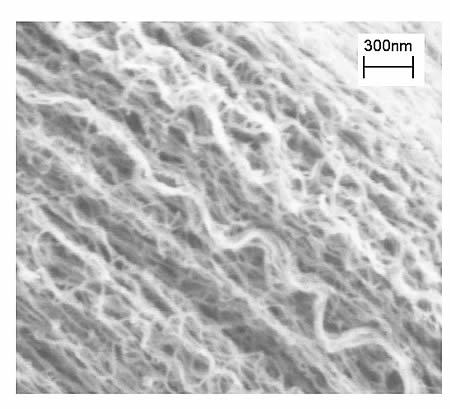Science Fiction
Dictionary
A B C D E F G H I J K L M N O P Q R S T U V W X Y Z
New Black From NASA Uses Nanotubes

A new black coating from NASA is super-absorptive; it's about ten times better than black paint ordinarily used by instrument designers. Inappropriately reflected light can ruin celestial photography; they need the blackest of blacks to get the best measurements.

( Multi-walled carbon nanotubes are tiny hollow tubes made of pure carbon )
Currently, instrument developers apply black paint to baffles and other components to reduce stray light. Because reflectance tests have shown the coating to be more effective than paint, instrument developers could grow the carbon nanotubes on the components themselves, thereby simplifying instrument designs because fewer baffles would be required.In addition to simplifying instrument design, the technology would allow scientists to gather hard-to-obtain measurements because of limitations in existing light-suppression techniques or to gather information about objects in high-contrast areas, including planets in orbit around other stars, Hagopian said.
Science fiction writers have been working with the idea of black coatings that are super-efficient; for example, the Tycho monolith from Arthur C. Clarke's 1968 novel 2001: A Space Odyssey:
"Now the sluggish sun had lifted itself above the edge of the crater, and its rays were pouring almost broadside pon the eastern face of the block. yet it seemed to absorb every particle of light as if it had never been. Floyd decided to try a simple experiment; he stood between the monolith and the sun, and looked for his own shadow on the smooth black sheet. There was no trace of it. At least ten kilowatts of raw heat must be falling on the slab.
Readers may also recall the absolute black from Restaurant at the End of the Universe (Douglas Adams, 1980) and fuligin from Gene Wolfe's 1980 classic Shadow & Claw.
Update 10-Nov-2011: Here's an early reference to the idea of a "blacker than black" coating for materials; see the black coating from E.E. 'Doc Smith's 1939 novel Gray Lensman. Thanks to Winchell Chung of Project Rho for the tip on this item. End update.
Take a look at some of these other efforts to create a real-world blacker-than-black material:
- Carbon Nanotube Blackness Blacker Than Black
You can see the National Institute of Standards and Technology reflectance standard (left), a sample of the new darkest material (center), and a piece of glassy carbon. - Femtosecond Laser Pulse Turns Metals Pitch Black
"We've been surprised by the number of possible applications for this," says Chunlei Guo, assistant professor of optics at the University of Rochester.
Scroll down for more stories in the same category. (Story submitted 12/5/2010)
Follow this kind of news @Technovelgy.| Email | RSS | Blog It | Stumble | del.icio.us | Digg | Reddit |
Would
you like to contribute a story tip?
It's easy:
Get the URL of the story, and the related sf author, and add
it here.
Comment/Join discussion ( 0 )
Related News Stories - (" Material ")
Harvard Metamaterials Change Structure Instantly
'Annealed in any shape for a time, and codified, the structure of that shape is retained down to the molecules.' - Samuel R. Delany
Nano-Chainmail 2D Mechanically Interlocked Polymer
'Nemourlon armor of reasonable weight resists penetration by most fragments and any bullet that is not both reasonably heavy and fairly high-velocity.' - Jerry Pournelle, 1976.
Goldene - A Two-Dimensional Sheet Of Gold One Atom Thick
'Hasan always pitched a Gauzy - a one-molecule-layer tent, opaque, feather-light, and very tough.' - Roger Zelazny, 1966.
FlexRAM Liquid Metal RAM And One Particular SF Movie Robot
'Its lines wavered, flowed, and then painfully reformed.' - Philip K. Dick, 1957.
Technovelgy (that's tech-novel-gee!) is devoted to the creative science inventions and ideas of sf authors. Look for the Invention Category that interests you, the Glossary, the Invention Timeline, or see what's New.
Science Fiction
Timeline
1600-1899
1900-1939
1940's 1950's
1960's 1970's
1980's 1990's
2000's 2010's
Current News
Natural Gait With Prosthetic Connected To Nervous System
'The leg was to function, in a way, as a servo-mechanism operated by Larry’s brain...'
Woman Marries Computer, Vonnegut's Dream Comes True
'Men are made of protoplasm... Lasts forever.'
Spidery 'Walk Me' Toyota Autonomous Wheel Chair Like Star Wars
Walk along with the emperor.
Dancing Robots Taught Dance Moves
'A clockwork figure would be the thing for you...'
Proof Of Robothood - Not A Person
'Who are you people? - Show 'em.'
Indonesian Clans Battle
'The observation vehicle was of that peculiar variety used in conveying a large number of people across rough terrain.'
The 'Last Mile' In China Crowded With Delivery Robots
Yes, it's a delivery robot. On wheels.
Tornyol Microdrone Kills Mosquitoes
'The real border was defended by... a swarm of quasi-independent aerostats.'
PLATO Spacecraft, Hunter Of Habitable Planets, Now Ready
'I ... set my automatic astronomical instruments to searching for a habitable planet.'
Factory Humanoid Robots Built By Humanoid Robots
'...haven't you a section of the factory where only robot labor is employed?'
iPhone Air Fulfils Jobs' Promise From 2007 - A Giant Screen!
'... oblongs were all over the floor and surfaces.'
ChatGPT Now Participates in Group Chats
'...the city was their laboratory in human psychology.'
iPhone Pocket All Sold Out!
'A long, strong, slender net...'
Did The Yautja Have These First?
What a marvel of ingenuity the little device was!
Jetson ONE Air Races Begin, Can Air Polo Be Far Behind?
'If you're one of those rarities who haven't attended a rocket-polo "carnage", let me tell you it's a colorful affair.'
Will Space Stations Have Large Interior Spaces Again?
'They filed clumsily into the battleroom, like children in a swimming pool for the first time, clinging to the handholds along the side.'
